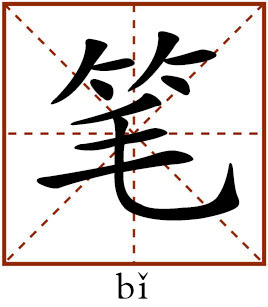Pen

This character refers to writing tools including pens, pencils and writing brushes.
下笔如有神
xià bǐ rú yǒu shén
Xia bi means “to write” and ru “like.” You shen means that “there is a god.” This term means that writing something good is so easy as if there were a god helping you.
This is a line from a poem by the Tang poet Du Fu (712–770). In 746, Du went to Chang’an (the capital of the Tang Empire) in an attempt to pursue an official career to serve the country. He took the imperial exam during the following year but failed. After a series of frustrations, Du was bitterly disappointed. In 748, he wrote this poem for an official who admired Du’s literary talent, expressing that he would leave Chang’an if he didn’t succeed. Two lines from this poem were famous ever since: “After reading more than ten thousand volumes, it is easy for me to write as if a god were there helping me.” Its meaning is similar to “Read wide, and you will wisely write.”
Nowadays, this is a saying that is often used to inform of the connection between reading and writing. The relationship between reading and writing has long been emphasized in China. It is said that “if you want to teach your student how to be an effective writer, you have to encourage them to be a voracious reader.” When readers potentially observe sentence and paragraph structures, variations in pacing, and recurring themes, these observations encourage readers to employ literacy skills and try to think like writers, a method that is helpful in the development of writing skills.
Another interesting fact is that “ten thousand volumes” (万卷, or wan juan) didn’t actually refer to ten thousand books, because bamboo and wooden slips were the main forms of media for writing in China before the widespread introduction of paper. The narrow strips of wood or bamboo typically carried a single column of brush-written text each, with space for several tens of ancient Chinese characters. For longer texts, many slips were sewn together to make a kind of folding book, which was called 卷 (volume). During the Tang Dynasty, the characters contained in one volume ranged from one thousand to tens of thousands.
Edited by REN GUANHONG

 PRINT
PRINT CLOSE
CLOSE